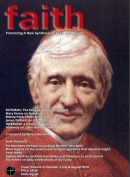Cutting Edge: Science and Religion News
Dr Gregory Farrelly FAITH MAGAZINE September-October 2014
Cosmological Blunders
As a physics teacher, my heart always sinks when I have to teach cosmology. The reason is that, unlike the rest of physics, we cannot do experiments on the whole universe; also, the observational data obtained comes from such a very small part of the universe’s history, rendering it difficult to extrapolate backward or forward in time with any certainty. Imagine aliens with no experience of human lifeforms observing a boy aged 9. They take measurements every hour for a year, a huge amount of data. In that year the boy’s height might increase from 134 to 138 cm, i.e. 4 cm per year. Much of cosmological theory is like the aliens extrapolating that in 50 years this ‘boy’ will become 200 cm (i.e. 50 times 4 cm) taller, a height of 338 cm, or about 11 feet! I always caution my students to be careful, therefore, about the conclusions of cosmology. Another real problem for cosmology is that our present knowledge of matter-energy only accounts for about 4% of what we find from observation in the universe; about 21% is very weakly interacting ‘dark matter’ and the remaining 75% ‘dark energy’, ‘dark’ here meaning undetectable.
Once again, the importance of philosophy, and particularly of metaphysics, is evident. When physicists arrogate to themselves a philosophical knowledge that they do no possess, problems will arise, doing damage to the reputation of science.
In the June edition of Nature, Paul Steinhardt highlights the dangers when scientists attract media attention without having first satisfied the necessary rigorous scientific analysis. A group of cosmologists announced at a press conference in March that they had detected gravitational waves, arising from the immediate aftermath of the Big Bang. This news became a sensation in the media,1 the results being hailed as proof of the Big Bang inflationary theory and of the existence of the ‘multiverse’.
A team of astrophysicists had used the BICEP2 South Pole telescope to identify a pattern in the polarisation maps of the cosmic microwave background radiation (rather like an echo of the Big Bang). They concluded that there was evidence of primordial gravitational waves. However, serious problems regarding the data analysis have put their findings into question. Other effects, such as light scattering from cosmic dust and the synchrotron radiation generated by electrons moving around galactic magnetic fields within our own galaxy, can also produce these polarisation twists. The BICEP2 instrument cannot distinguish the cosmic contribution from other sources directly, so, measurements of galactic dust collected by other sources, such as the Planck satellites were used. When the BICEP2 team did its analysis, the Planck dust map had not yet been published, so the team extracted data from a preliminary map that had been presented several months earlier. However, a reanalysis at Princeton has concluded that the BICEP2 pattern could be the result of effects that are non-gravitational.2 The fiasco resulting from the press conference is a reminder that announcements should be made after submission to peer-reviewed journals with enough detail to allow independent verification.
The ‘multiverse’ hypothesis arises from a particular view of quantum mechanics, in which the outcomes of an event have a certain probability. Here, a correct set of results can be obtained by positing that each possible outcome occurs in a separate universe or ‘multiverse’. The observer is ‘stuck’ in a particular multiverse, unable to detect the existence of other multiverses. The multiverse theory is particularly appealing to atheist scientists as it contradicts the ‘anthropic principle’, the idea that our universe is ‘fine-tuned’ for humanity, a view espoused by Faith. In the multiverse explanation, our universe is merely one that has the parameters that are, by definition, necessary for human observation, but billions of other multiverses exist in which the parameters are different and in which human life would be impossible. In this view, our multiverse is not ‘special’, it is merely the one in which we happen to be.
Gravitational waves result from “inflation” of the early universe, an exponential expansion of space in the first fraction of a second of the Big Bang, 14 billion years ago. Inflation and dark energy cannot be accounted for easily using known physics, but if our ‘universe’ is merely one of millions of multiverses, this could account for the fact that particular values of the dark energy are weaker than one might otherwise have supposed. In many cosmological models, if there is inflation, there is a multiverse.
Steinhardt points out that inflationary theory in cosmology is supposed to be highly predictive, yet in this set of observations the realisation that gravitational waves have not actually been detected seems not to have caused any doubt about the theory. Some advocates of the theory state that it is so flexible that it is immune to experimental/observational tests for two reasons:
1. Inflation is driven by a hypothetical scalar field with properties that can be adjusted to effectively produce any outcome.
2. Inflation does not result in a universe with uniform properties, but a multiverse with an infinite number of ‘bubbles’ in which the cosmic and physical properties vary from bubble to bubble. Scanning over all possible bubbles in the multiverse, everything that can physically happen does happen.
This means that no experiment can falsify a theory since it allows for all possible outcomes. The fundamental problem here is that an unfalsifiable theory is unscientific. Indeed Steinhardt concludes that “it is clear that the inflationary paradigm is fundamentally untestable, and hence scientifically meaningless”.4
Once again, the importance of philosophy, and particularly of metaphysics, is evident. When physicists arrogate to themselves a philosophical knowledge that they do no possess, problems will arise, doing damage to the reputation of science.
Dr Gregory Farrelly is a physics teacher at Cambridge Tutors College, Croydon.






